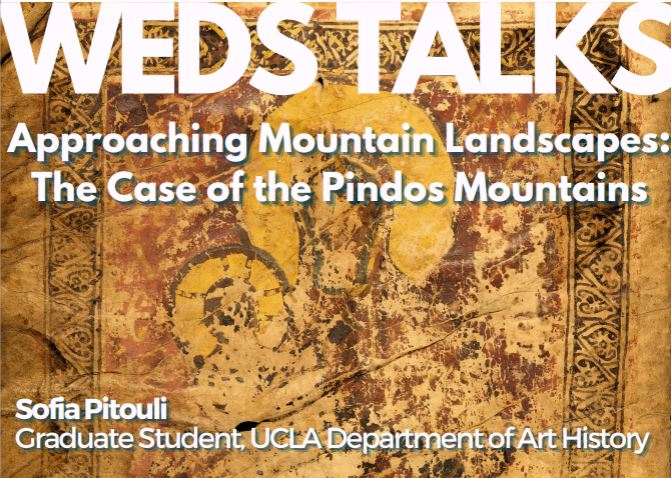Past Events
Interested in Cotsen events? Sign up for our mailing list.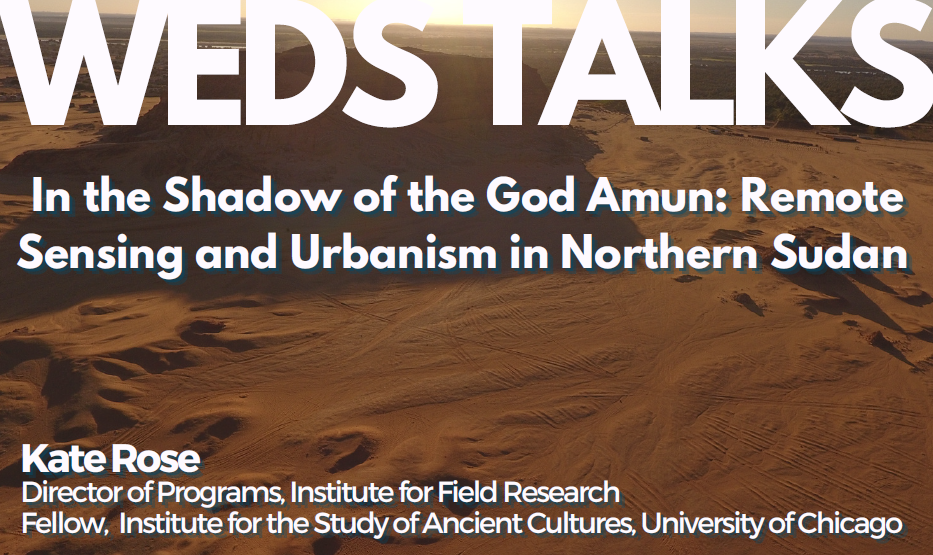
ABSTRACT: This presentation investigates urbanism and settlement patterns through multiple lines of remote sensing data in Northern Sudan. The site of Jebel Barkal, located 400 km from Khartoum, near the Nile, is known for its elite palaces, temples, and pyramids. The site served as the royal capital of Kush from the 8th century BCE and remained a major urban and religious center throughout the Meroitic Period. Recently a Meroitic settlement was identified, known as the “East Mound.” Since 2018 the Jebel Barkal Archaeological Project, in collaboration with the National Corporation for Antiquities and Museums of Sudan, has been excavating and surveying areas of the East Mound. This talk will present preliminary results of a new project aimed at analyzing LiDAR and thermal imagery data. The LiDAR and the thermal imagery extend beyond the East Mound into the modern dense and lush agricultural fields adjacent to the Nile. The data will allow us to more accurately map the settlement’s spatial extent and situate it within its broader landscape context. Objectives also include identifying any previously undocumented features such as architecture, activity areas, and paleochannels. This work contributes to our understanding of how major Kushite cities grow, evolve, and respond to environmental factors throughout their life histories. Lastly, this project ruminates on the impact of archaeological inquiry in Sudan, which is currently experiencing a civil war after years of political unrest, while centering Sudanese voices and local archaeologists.
BIO: Kate Rose is an anthropological archaeologist, specializing in landscape analysis and ancient urbanism in the Near East and North Africa. Her PhD dissertation at Harvard University is a comparative spatial analysis of Kushite royal cemeteries in Northern Sudan. As a researcher with the ERC DiverseNile Project at Ludwig-Maximilians-Universität in Munich, Germany from 2022 to 2024, she investigated landscape changes during the Bronze Age borderspace of the Attab to Ferka region. She has also held numerous lectureships and teaching positions at Harvard University and Boston University, and is interested in the intersection of pedagogy and fieldwork. She has served in various leadership positions on projects in Sudan, Egypt, Jordan, Turkey, and Spain. She is currently the Director of Programs at the Institute for Field Research, and a Fellow with the Center for Ancient Middle Eastern Landscapes at the Institute for the Study of Ancient Cultures, University of Chicago.
Contact Sumiji Takahashi
Email sutakahashi@ioa.ucla.edu
Phone 310-825-4169
ABSTRACT: An imperial document (chrysobull), issued in 1289 by Byzantine Emperor Andronikos II Palaiologos, confirms the privileges granted to a monastic foundation known as the Merciful Virgin in Phanari, Karditsa. The monastery was established by the sebastokratorissa Hypomone, a nun of Vlach origin who came from the transhumant nomadic group that moved between the Pindos Mountains and the Thessalian plateau. While only fragments of her monastic foundation survive today, this imperial document, read together with material evidence, offers insights into the overlapping landscapes between lowlands and uplands in the thirteenth century.
BIO: Sofia is a PhD candidate in the Department of Art History at UCLA. Her dissertation, “The Pindos Mountains: Land, Art, Community (13th-15th centuries),” explores how mountainous communities interacted with land by analyzing settlement and mobility patterns and artistic and social interactions across mountains and surrounding plains. She has received fellowships from the CMRS Center for Early Global Studies, the UCLA Stavros Niarchos Center for Hellenic Studies, Dumbarton Oaks, and the Mellon Foundation. She is the co-editor of the catalogue Weaving Dreams: Kilims from Geraki, Laconia, and has published articles on medieval soundscapes and communities.
Contact Sumiji Takahashi
Email sutakahashi@ioa.ucla.edu
Phone 310-825-4169
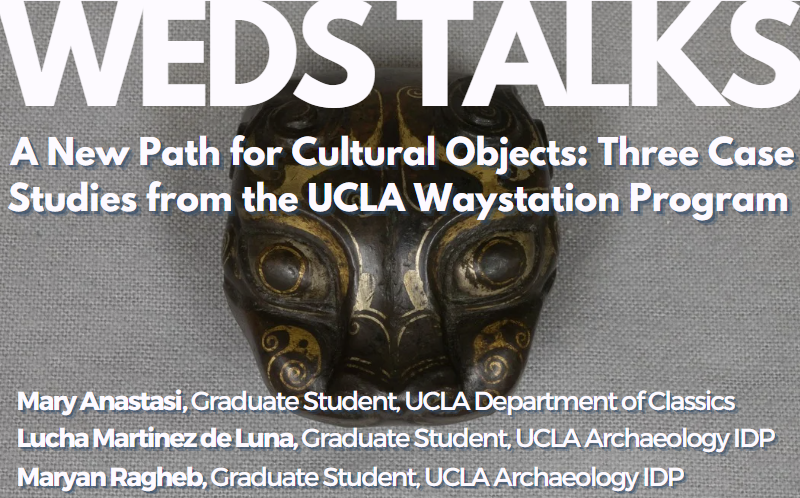
ABSTRACT: In 2023, the Cotsen Institute of Archaeology debuted its new graduate certificate in Cultural Heritage Research, Stewardship, and Restitution as part of the Waystation Initiative, which organizes and facilitates ethical returns of international archaeological and ethnological objects to the nation or community of origin. In this presentation, Lucha Martinez de Luna, Maryan Ragheb, and Mary Anastasi share the results from their first year working with Waystation. By combining provenance and art historical research with material analysis, they were able to compile object histories for various cultural objects from ancient China to reconstruct the life history of these objects. In the future, these and other cultural heritage artifacts will be returned to Shandong University in China, accompanied by provenance information obtained through our work with the Waystation. .
BIOS: Mary Anastasi is a PhD candidate in the Classics department at UCLA. Her research interests include philosophy, rhetoric, Imperial Greek literature, and epistolography, and she regularly teaches courses in Classics and Ancient Greek. Mary completed the Waystation certificate in the spring of 2024.
Lucha Martinez de Luna is an a PhD candidate in archaeology at the Cotsen Institute of Archaeology focused on Mesoamerican and Contemporary Archaeology. She has participated in archaeological projects in the Southwestern U.S., the American West, and central and southern Mexico and curator of archaeological and historical museum collections. As the La Providencia Archaeological Project director and a visiting professor at the University of Science and Arts in Chiapas, Mexico, Lucha also leads the Chicano/a/x Murals of Colorado Project.
Maryan Ragheb is a PhD candidate in archaeology at the Cotsen Institute of Archaeology who works in ancient Egypt. Her dissertation addresses people’s interactions with their material culture during social change in ancient Egypt, focusing on body ornamentation production and practices. Maryan worked on different archaeological projects in Egypt and Ethiopia. For the Waystation Certificate Program, she worked on jade neolithic objects from China.
Contact Sumiji Takahashi
Email sutakahashi@ioa.ucla.edu
Phone 310-825-4169
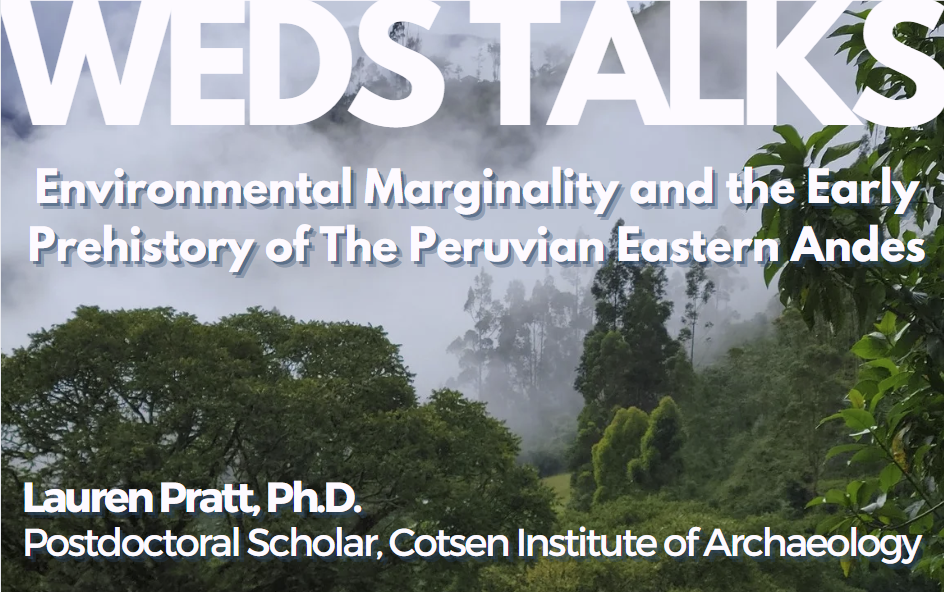
ABSTRACT: Archaeological models of human activity in the Peruvian eastern Andes prior to c. 1000 cal BP are enormously variable, ranging from near-total absence through selective or seasonal use to extensive local development and inter-regional exchange. Much of this disagreement is founded in competing evaluations of the environmental marginality of cloud forests and other eastern Andean environments for human occupation. As direct archaeological evidence of human activity from this place and time are scarce, evaluation of models has been difficult, relying largely on theory and indirect evidence from neighboring regions. In this talk, I present the results of the CARECH project, a multi-site archaeological survey and excavation initiative which offers insights into more than 4,000 years of human adaptation to, and modification of, eastern Andean environments, from Middle Holocene (c. 5,500 cal BP) foragers through the development of sedentary agriculturalism. Based on these results, the cloud forest appears to have been highly suitable for past human groups, who may also have modified the landscape to better suit their needs. In addition, I will discuss upcoming work in the cloud forests of southern Peru, designed to assess the role of the eastern Andes in facilitating highland-lowland interactions.
BIO: Lauren Pratt is a postdoctoral scholar at the Cotsen Institute of Archaeology. She received her doctoral degree from the University of Michigan in August 2024, with a dissertation titled "Human Ecology of the Early Prehistory of the Eastern Andes, Peru." She employs a variety of approaches, including human-behavioral ecology and niche construction, to understand human-environment interactions in the cloud forests and adjacent environmental settings at the intersection of South America's two defining landscapes: the Andes mountains and Amazon rainforest.
Contact Sumiji Takahashi
Email sutakahashi@ioa.ucla.edu
Phone 310-825-4169
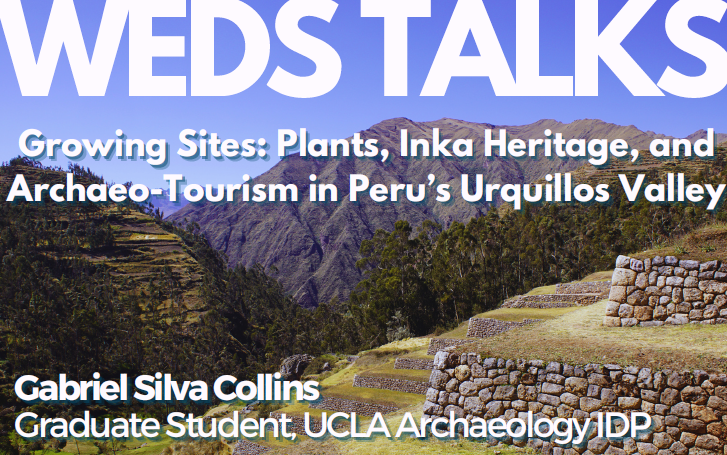
ABSTRACT: Southern Peru's Urquillos Valley hosts a series of Inka sites that exist in various states of integration with homes, farms, and the Peruvian tourist economy. Local Indigenous communities' ongoing use of these Inka sites frequently puts them at odds with the Peruvian government's Ministry of Culture, which often seeks to transform locally-managed "ruins" into state-run "archaeological sites." Examining three sites within the valley—Inkaq Mallquin, Apiypanki, and Choquekasantuy—reveals that different points in this transformative process can be linked to differences in plant communities living on those sites. Contemporary plants on heritage sites are both proxies for and drivers of archaeology-associated social, economic, and physical changes to the valley's Inka sites. In this talk, I study how botanical ecologies are employed by competing groups in struggles for control over land and heritage in the Urquillos Valley, and propose that a form of ecological imperialism is involved in creating proper archaeological sites as envisioned by Peru's Ministry of Culture.
BIO: Gabriel Silva Collins is a third-year PhD student at the Cotsen Institute of Archaeology. He received a BA in Anthropology from Williams College, and completed his MA in Archaeology at UCLA last spring. Gabriel's mixed archaeological and ethnographic research has focused on the relationships between precolonial Peruvian archaeological sites and the people who now live in, on, and around them. His dissertation work will continue these themes while examining a group of understudied sites near Cochabamba, Bolivia.
Contact Sumiji Takahashi
Email sutakahashi@ioa.ucla.edu
Phone 310-825-4169
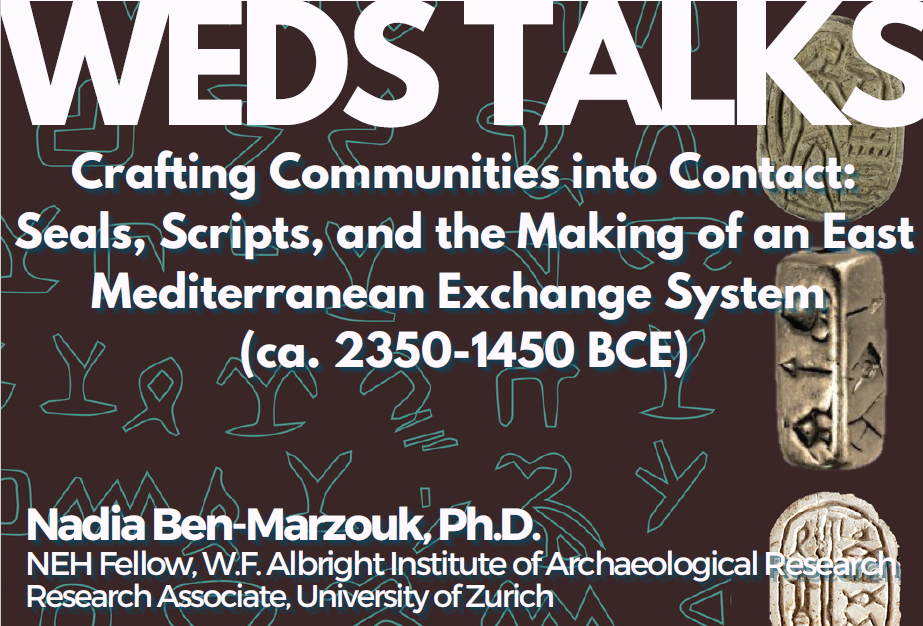
ABSTRACT: The late third to early second millennium BCE is characterized by the unprecedented movement of goods, people, and ideas alongside the development and spread of shared social practices and innovations in the east Mediterranean. It’s against this backdrop that we see the widespread appearance of emergent writing systems with (semi-)pictographic scripts and so-called “pseudo scripts”, many of which share similar graphemes and almost all of which appear on stamp seal amulets. Traditional scholarship has sought to understand the extent to which the Egyptian writing system impacted on local script formation, limiting stimuli to writing practices from one geographic region. This talk takes a craft-centered interregional approach, evaluating these scripts in relation to one another and proposing they evolved, in part, alongside a shared visual language reflecting a common repertoire of symbols and practices marking membership in a transregional community of exchange.
BIO: Nadia is currently an NEH Fellow at the W.F. Albright Institute of Archaeological Research and a research associate at the University of Zurich. She was a postdoctoral researcher on the Swiss National Science Foundation funded Sinergia project, “Stamp Seals from the Southern Levant” (2021–2023) after receiving her Ph.D. in Levantine Archaeology from the University of California, Los Angeles. Her research examines craft production in the Bronze Age eastern Mediterranean, with a focus on the identities and embodied knowledge of producers and the contexts in which innovations arose. Nadia has co-edited several volumes including Ancient Egyptian Society (2022, Routledge), two special issues of Near Eastern Archaeology (2023–2024), and two edited volumes on stamp seal production and typology (forthcoming, Peeters). She is currently working on a Cambridge University Press Element titled Social Identity in Ancient Egypt, as well as a book exploring the role of craftspeople in the making of an east Mediterranean exchange system.
Contact Sumiji Takahashi
Email sutakahashi@ioa.ucla.edu
Phone 310-825-4169
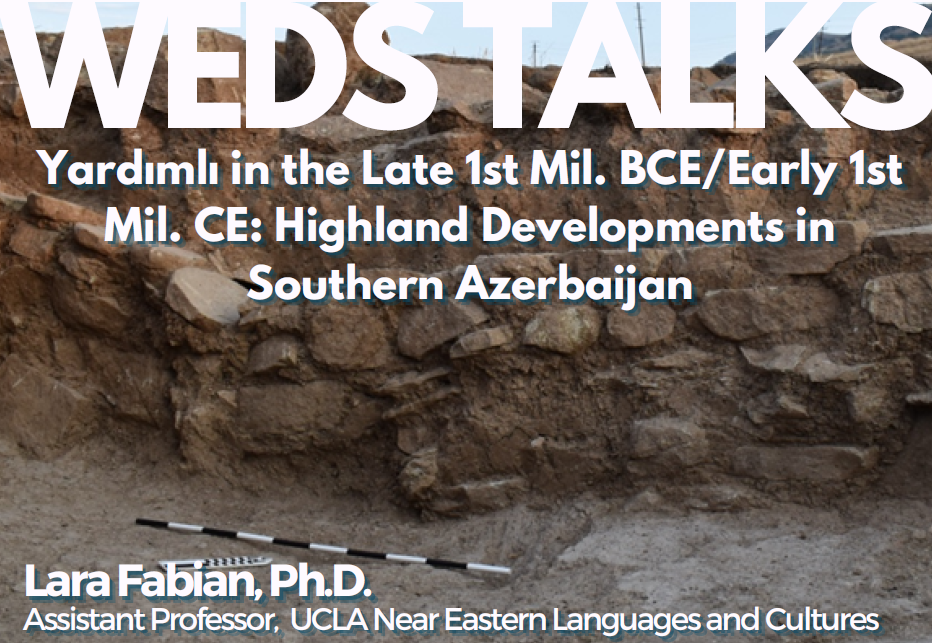
ABSTRACT: Highland landscapes present both conceptual and practical challenges for archaeology and archaeologists, and remain both understudied and undertheorized. In this talk, I will discuss those issues and how they have informed fieldwork that I and my collaborators (Hannah Lau and Jeyhun Eminli) have been conducting in the Talış Mountains in recent years. This highland zone, which is part of the Alborz range, is a unique ecosystem at the southern limits of the Caspian Sea. I will highlight results of fieldwork from our 2024 season of SHARP (the Southeastern Highlands Archaeological Research Project) in the Yardımlı district of Azerbaijan, where we have begun to expose a surprisingly landscape of large-scale stone-built architecture dating to the late 1st millennium BCE, providing entirely new datapoints for our understanding of post-Achaemenid developments in this region.
BIO: Lara Fabian is an assistant professor of Iranian archaeology in the department of Near Eastern Languages and Cultures at UCLA whose work focuses on Iran and the Caucasus, and broader Southwest Asia, in the Iron Age and later. Her current book project considers the material imprint of empire in its afterlife through an examination of the post-Achaemenid world. Her scholarship is informed by historiographic and reception studies on the development of thought about antiquity and the question of Iran in the Russian Empire, Soviet Union, and post-Soviet Eurasia. As part of this wider research, she has co-directed collaborative Azerbaijani-American fieldwork in Azerbaijan since 2016. Before coming to UCLA, she worked on the “Beyond the Silk Road” ERC project at Albert-Ludwigs-Universität Freiburg.
Contact Sumiji Takahashi
Email sutakahashi@ioa.ucla.edu
Phone 310-825-4169
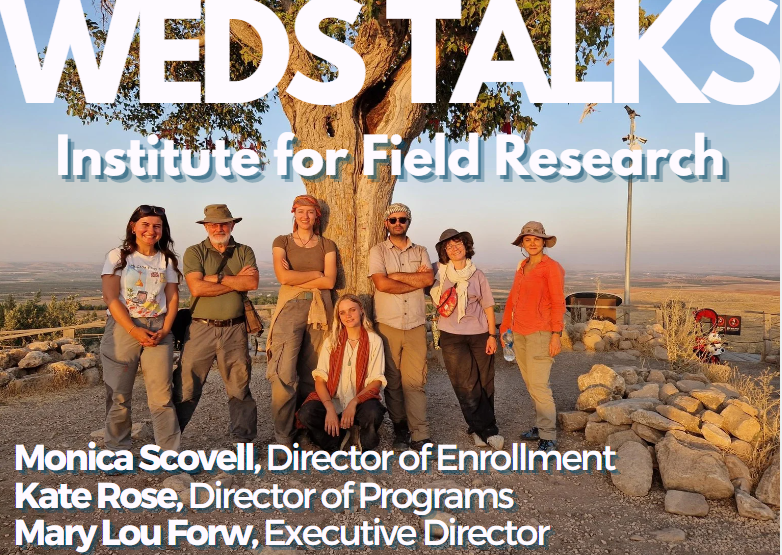
ABSTRACT: Are you thinking about a field school this summer or next year? Come learn about the unique programs offered through IFR, the Institute for Field Research. UCLA students who previously completed a program will be there to share their experiences, and we'll have time to answer any questions you might have about field schools for us or your peers. IFR programs allow you to embrace your curiosity while earning academic credit and gaining practical hands-on experience for future work or studies. We will also share information about a scholarship just for LA students attending our field schools.
BIO: The Institute for Field Research (IFR) is a faculty-founded non-profit that supports field schools in the USA and abroad in a range of disciplines including archaeology, anthropology, curation, and earth/enviro studies. The IFR’s mission is to transform individuals and communities through experiential education and field research. By working with leading scholars from academic institutions around the world, the IFR delivers evidence-based field science programs in a broad range of disciplines while ensuring excellence in research and teaching.
Contact Sumiji Takahashi
Email sutakahashi@ioa.ucla.edu
Phone 310-825-4169
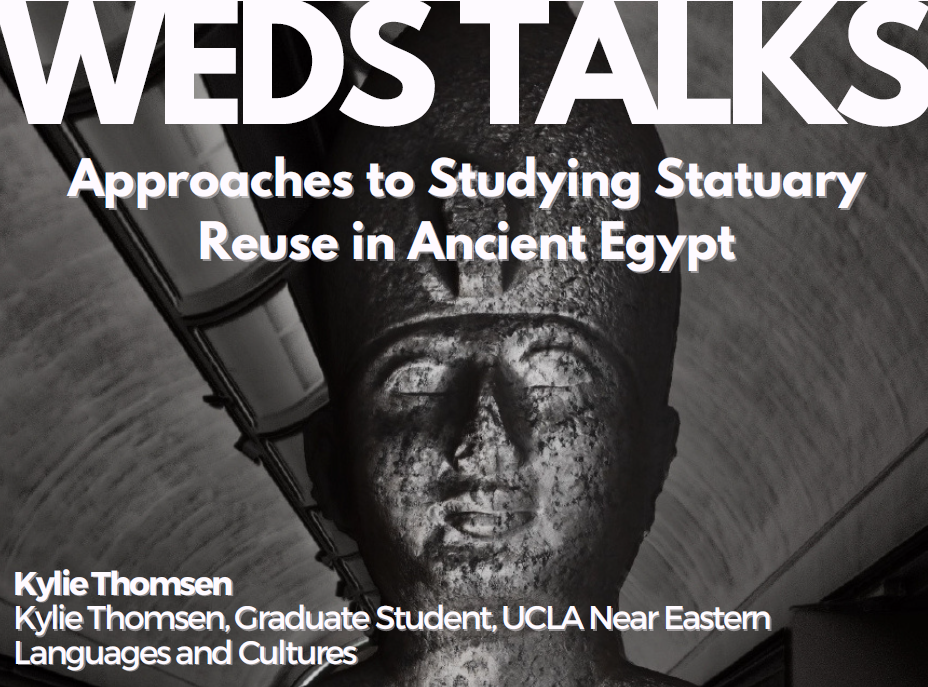
ABSTACT: Statuary reuse was an episodic practice in ancient Egypt. Reuse of a statue could range from actions not obvious in the archaeological record, such as moving a statue to a secondary location by a different owner, to the transformation of a statue by modifying its inscriptions, reworking its features, or even the destruction of a larger statue to craft several smaller ones. However, depending on the extent to which the object was modified and its overall preservation, it remains difficult to systematically study, particularly over time and space. This presentation will focus on approaches to identifying the actions associated with statuary reuse in order to better analyze the object’s life history through the modifications it underwent. Through this, I aim to contribute to the understanding of the intent(s), context(s), and reception(s) of statuary reuse in ancient Egypt, as well as the technical strategies employed by the ancient craftspeople who altered these objects for their later uses.
BIO: Kylie is an Egyptology PhD candidate in the Department of Near Eastern Languages and Cultures at the University of California, Los Angeles. She received her BA in anthropology from the University of Arizona and her MA in Egyptology from Indiana University Bloomington. She is currently a researcher and graphic designer for the UCLA Coffins Project, which investigates coffin reuse in ancient Egypt during the Third Intermediate Period. Her dissertation research focuses on the documentation and contextualization of ancient Egyptian statuary reuse, including documenting statues via high-resolution photography, photogrammetry, RTI (reflectance transformation imaging), and traditional art historical methods in order to analyze the statues for signs of recarving, reinscribing, and other indicators of object reuse.
Contact Sumiji Takahashi
Email sutakahashi@ioa.ucla.edu
Phone 310-825-4169
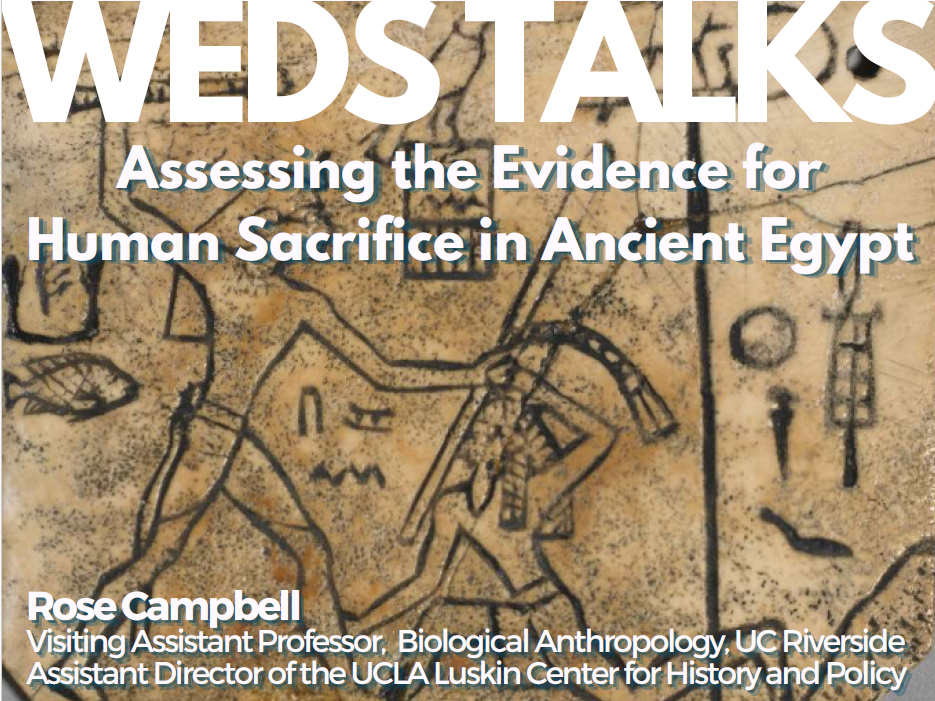
Abstract: During the 19th century, archaeologists in Abydos, Egypt, uncovered hundreds of small, relatively simple graves surrounding the funerary complexes of the first kings of Egypt in the 4th millennium BCE. Ever since these burials were discovered, scholars have debated whether the individuals within these subsidiary burials were sacrificed to accompany their ruler into the afterlife, or were simply buried close to their royal tomb after dying naturally. Previous scholarship has largely focused on aspects of the burials as well as the political and social context of the time period, rather than assessing the human remains within the graves. This lecture will present evidence from the human remains themselves, which complicates our understanding of First Dynasty funerary practices, as well as our interpretations of state-sanctioned violence and power in the past.
Bio: Roselyn A. Campbell is an archaeologist, bioarchaeologist, and Egyptologist. She earned her PhD at the Cotsen Institute of Archaeology, and an MA in Anthropology from the University of Montana. She is currently a Visiting Assistant Professor of Biological Anthropology at the University of California, Riverside, and the Assistant Director of the UCLA Luskin Center for History and Policy. Her research focuses primarily analyzing trauma in human remains to gain an understanding of violence as a tool of power in the past, but she also researches the history of cancers in human remains and health and Egyptian funerary archaeology
Contact Sumiji Takahashi
Email sutakahashi@ioa.ucla.edu
Phone 310-825-4169
- ‹ previous
- 3 of 22
- next ›



